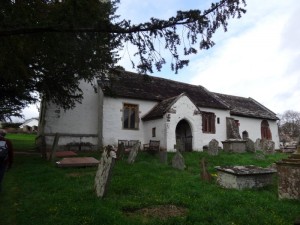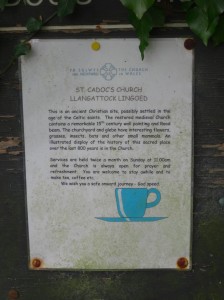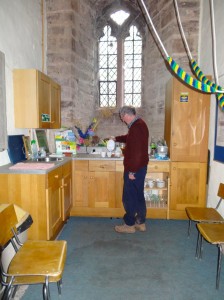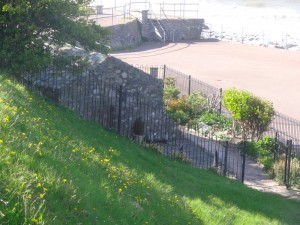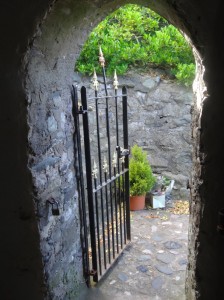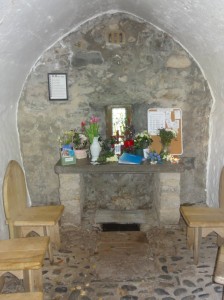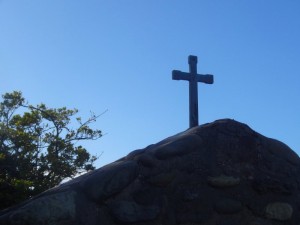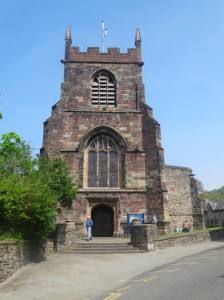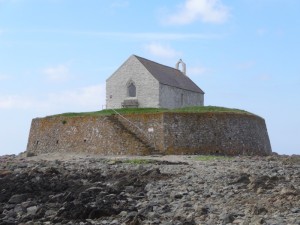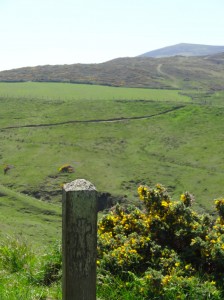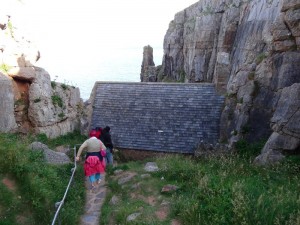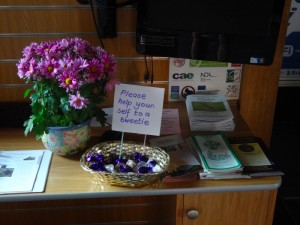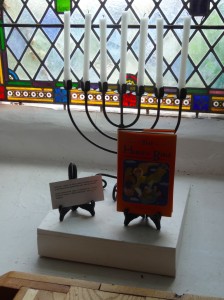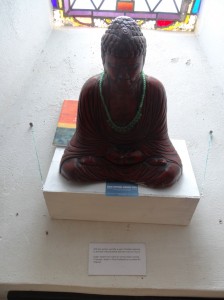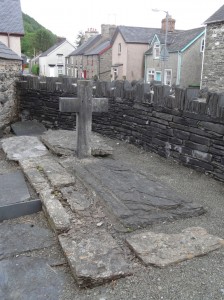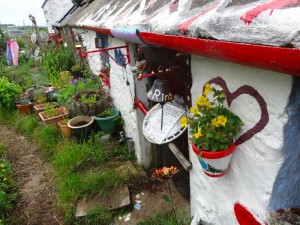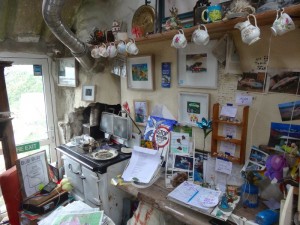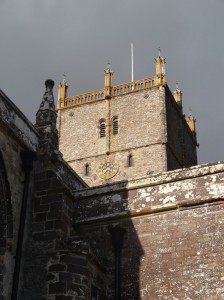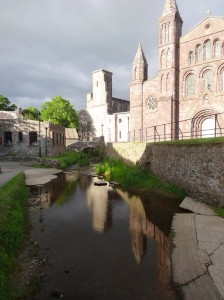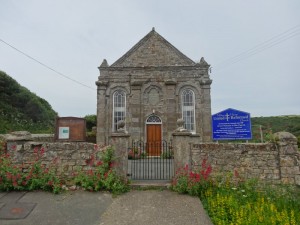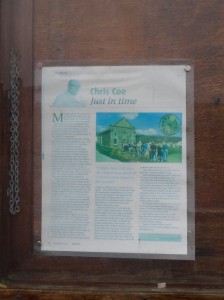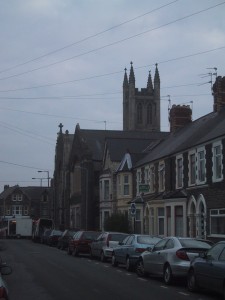Sermon 25th August 2013 at Tiree Baptist Church
John 13:31–35:
31 When he had gone out, Jesus said, “Now is the Son of man glorified, and in him God is glorified; 32 if God is glorified in him, God will also glorify him in himself, and glorify him at once. 33 Little children, yet a little while I am with you. You will seek me; and as I said to the Jews so now I say to you, ‘Where I am going you cannot come.’ 34 A new commandment I give to you, that you love one another; even as I have loved you, that you also love one another. 35 By this all men will know that you are my disciples, if you have love for one another.”
During my walk around Wales I saw many churches, some just from the outside, some from inside. Sadly, because I had underestimated just how long the walking would take, in very few cases did I met or talk to people inside, so the impressions are often on outside appearances only.
In the following I’ll talk about a few of the churches, and some of the impressions and biblical themes that each suggested to me. At first I had thought that there was no overriding theme and the passage from John was just one of the passages. However, I gradually realised that amongst the many issues raised the expression of love was a factor in almost all.
Christ’s single criterion test
Imagine you are a chemist and trying to verify whether the substance in a test tube is bromine-hexachlorate1). First you might dip a metal filament in it and heat it over a Bunsen burner flame. It burns green: tick; that is right. Then you dribble a little hydrochloric acid in and it fizzes: tick again. You then try sulphuric acid, but this time it does not react, but that also is correct. You gradually work your way through the complete suite of tests and if it satisfies all the criteria, you can be sure it is right.
In medicine things are a little more complex. Once I had a pain in my chest. I thought it was just a muscle spasm, but after an hour it was still there. I eventually rang NHS direct who asked a whole series of questions, clearly focused on heart attackes: was it spreading etc., The answer to them all was “no”, but there was one exception, “are you over 40”. I thought, “that’s OK”, because my symptoms did not meet the overwhelming majority of the criteria, but that one risk factor was enough for them to say, “the ambulance is on its way”. Happily, it turned out to be simply muscle pain as I’d first thought, but in medicine the match between multiple symptoms and underlying cause is complex.
Jesus made it easy for us. He offers a single criterion test for recognising a true disciple: “By this all men will know that you are my disciples, if you have love for one another“.
Of course Jesus often uses hyperbole, so it may be this is a example, but it follows immediately Jesus “New Commandment”. When asked earlier he had said that the greatest commandment was “Love the Lord your God with all your heart and all your might“, and the second, “Love your neighbour as yourself.” Here he adds to these two ancient commands one of his own: “Love one another as I have loved you“. This is the love that goes to the cross, that suffers humiliation and pain, it was no small thing he asked and commanded of his companions. This was also said just after Judas had left to betray Jesus and the last chance to teach his disciples. He chose his time and his words carefully.
Churches with tea on Offa’s Dyke
The first church I’d like to take us to visit is St Cadoc’s in Llangattock Lingoed. The sign outside notes that there was probably a church at this site from the times of the Celtic saints, and that the current building is Mediaeval, with 15th century paintings and a Rood beam. Inside it is indeed a beautiful building and the church wardens would have every reason to want to preserve it as the ancient building it is deserves. Indeed the paintings and Rood beam are visible and the church has clearly been preserved well, maybe with help for historic grants.
However, on the notice there is also an image of a tea-cup. Inside this ancient church, at the back of the church is a set of kitchen units with tea and coffee supplies and biscuits so that walkers and passers-by can take refreshment.
This is one of a number of churches along the length of Offa’s Dyke that offer refreshments, sometimes simply a kettle on a pew at the back of the church, sometimes on a small table, and in this case a full kitchen.
I cannot understate the importance of this to the walker. On my first day of Offa’s Dyke there was no cafe or shop to get refreshments the whole way, my first food the entire day was at 8pm.
In Hebrews, we read:
Hebrews 13:1–2
1 Let brotherly love continue. 2 Do not neglect to show hospitality to strangers, for thereby some have entertained angels unawares.
I was no angel, nor, to my knowledge, were the other walkers I saw in the church, but the hospitality was no less welcome
However, it is also worth thinking about the words leading up to this statement.
Hebrews 12:28–29
28 Therefore let us be grateful for receiving a kingdom that cannot be shaken, and thus let us offer to God acceptable worship, with reverence and awe; 29 for our God is a consuming fire.
The charge to “let brotherly love continue“, and the to show hospitality is a direct expression of acceptable worship and the burning presence of our Lord.
In other places, notably Romans 12, the New Testament writers talk about this gift of hospitality, and this has been a traditional aspect of churches. Old abbeys would have cloisters and chapels for prayer and praise, but also a ‘hospital’, which was not just a place for the sick (but would include an ‘infirmary’ for this), but more a place for pilgrims and passersby to receive ‘hospitality’.
Although it seems a small thing, I again cannot understate the power of this simple expression of love, for me as a Christian, but I am sure also for those who are not. By this shall all people know …
Ffynnongroyw
While there were some Methodist and other Non-Conformist chapels up the eastern borders of Wales, it was more a place of sleepy rural villages and Anglican Parish Churches, some Church of Wales, some Church of England depending on which side of the bordre the village lay.
I was brought up in Cardiff and in the city itself and the coal valleys above it seems there is a chapel on every corner. In the decaying industrial towns and villages of North East Wales, this was no less true.
Ffynnongroyw, which in Welsh means ‘clear well’, was one such village. Along its short street I counted five chapels in addition to the Parish Church. All the chapels were closed, most already converted into residential use.
The chapels will have been built during one of the periods of revival when nearly every villager would have one to one or the other. The population will have shrunk with the decline of industry, but even given that, it is hard to imagine that the small village could every have really supported so many places of worship.
Gill’s Commentary on John 13:35 reads:
as Christ has loved his people freely, notwithstanding all their unworthiness and ungratefulness, so should they love one another, though there may be many things in them observable, which are disagreeable; as Christ loves all his children without any distinction, so should they love one another, whether poor or rich, weaker or stronger, lesser or greater believers; and as Christ loves them not in word only, but in deed and in truth, so should they love one another with a pure heart fervently, and by love serve one another.
Matthew Henry is even more forthright:
By this it appears, that if the followers of Christ do not show love one to another, they give cause to suspect their sincerity.
(both quotations from: http://biblehub.com/john/13-34.htm)
In one way this proliferation of buildings is testament to the wonderful outpouring of the spirit in the past, but it is also testament to the sad and often bitter divisions that rent the church in even this most glorious time.
Ffynnongroyw was also the location of what I think was the most spiritually saddening sights of the entire trip. A chapel, now closed up for sale, with a schoolroom added that had clearly been built comparatively recently, perhaps 20 years ago or so. It is sad because it speaks of the decline of the church in this area, but more so because of the hubris whereby the church put effort into this building project, when it could have put its efforts into working with other Christians in the village.
Now maybe there is another story that I cannot see from the outside, but certainly one again and again hears stories of ministers worn down by the petty divisions amongst neighbouring churches. Some years ago, a friend of a friend was part of the Methodist team ministry in the South Wales Valleys. In one village at opposite ends of the same street were two Methodist churches. Neither church had more than half a dozen members, but they refused to worship together because they were historically from different branches of the church.
This is a disaster for the churches involved, but no less for those who look on the church and do not see, as Jesus said they should, a community bound by its Christ-like self-sacrificing love for one another.
St Trillo’s
Further along the coast is St Trillo’s church, the smallest church in Wales, and possibly in the whole of Britain. It is barely the size of a living room, just six chairs and an alter. It is between the road and the sea as the road goes round the headland at Rhos-on-Sea, but if you drive you would pass it without noticing as the church ridge rises no more than ten foot, and even the cross on its roof is below the level of the road.
However, as you walk round the promenade it is unmissable, a haven of rest. Here it is not cups of tea that is needed, you can easily get these from the kiosks in Colwyn Bay, but a place to find peace and prayer.
Psalm 84:1–2
1. How lovely is thy dwelling place, O Lord of hosts!
2 My soul longs, yea, faints for the courts of the Lord;
my heart and flesh sing for joy to the living God.
Bangor Cathedral
Bangor Cathedral seems very small, much smaller than St David’s, which I thought was the smallest cathedral in Wales. However, as I write I have checked and St David’s is the smallest Cathedral city, not the smallest building. In fact St Asaph’s, which was just off my route in North-East Wales, is the smallest Cathedral. However, Bangor is the oldest Cathderal in Britain, founded in 525.
However, it is not for its size nor age that I’ve included it here, but for what I saw as I entered. It was a Friday, so I expected the normal quiet rustle of tourist amongst the aisles, but instead there was a scene of glorious (but relaxed) activity in preparation for Penticost, a banner of flames being raised against each pillar.
I later realised that there was a Diocesan family gathering at the Cathedral the next day. As I walked down the North-West Wales coast I found that the different parish magazines, described the experiences of groups who had been including arts activities and worship.
The other immediate sight on entering the Cathedral was a large freestanding banner, of the roll-up PVC kind you often see at conferences. It was right by the door and was about the local food bank, which, I think, was administered from the Cathedral. The sight of both food banks and various forms of pay-day loan and buy-back/pawn shops is now common in towns and cities across the country. In so many ways it feels we are falling back into Victorian times.
James 2:5–17
15 If a brother or sister is ill-clad and in lack of daily food, 16 and one of you says to them, “Go in peace, be warmed and filled,” without giving them the things needed for the body, what does it profit?
It was wonderful to see the Cathedral taking a leading role in fulfilling this Biblical injunction, but also to see these works of hospitality and generosity alongside signs of the active spirit-filled life of the worshiping church.
Church in the Sea
The little church of St Cwyfan sits on an artificial, grass-topped island connected to the land by a small tidal causeway. When I first saw it I assume hermits living on the small island and then gradually building the tall walls and filling it with earth and rock to create the current island. However, when I later checked I found that, in fact, the church had started out on the shore, but over the years the soft agglomerate rock, barely more than earth and stone rubble, has eroded and the walls were made to protect the church until it was left stranded from the land.
There are various ways one could look at this, most obviously the house built on rock:
Matthew 7:24–25
24 “Therefore everyone who hears these words of mine and puts them into practice is like a wise man who built his house on the rock. 25 The rain came down, the streams rose, and the winds blew and beat against that house; yet it did not fall, because it had its foundation on the rock.
And yet, the ‘rock’ on which this church was built was not solid rock, like the three billion year-old Lewissian Gneiss beneath our feet on Tiree. Instead, it is soft crumbling rock, easily washed away, in fact more like the foolish man and the sand.
However, the logic of God is often at odds witn the logic of man. After Jesus resurrection, he addresses Peter:
Matthew 16:18
18 And I tell you, you are Peter, and on this rock I will build my church, and the powers of death shall not prevail against it.
Note this is Peter, who always manages to put not just one, but both feet, into any trouble, Peter who has run away at Gethsemane, and then, in fear, denied that he knew Jesus, not once, but three times. This is the rock on which Jesus plans to build his church?
Indeed Peter is not so different from the soft aggregate under St Cwyfan’s, easily washed away by the winter storms, and yet, surrounded by the love of Christ, made strong enough to hold a church. We are constantly called to great things, not in out own strength, but in the strength of he who calls us.
Pilgrim route and ancient sites
There are many ancient Christian sites scattered around the coast of Wales and a number of pilgrim routes that cut across the country. Many of these cut inland, but some lie along the coast.
Walking along the north coast of the Lleyn Peninsula, I came to a stile on which was a scallop shell, the symbol of the El Camino de Santiago pilgrimage routes. This was the route to Bardsey Island off the far western tip of Lleyn. Below the scallop was a small notice, from a campsite beside the path, saying, “pilgrims welcome to camp here or use our facilities”.
Some people following these pilgrim routes today will be Christians. One of the books I read on my journey was that of Alice Warrender, who undertook a pilgrimage to Rome after a major bicycle accident. However, there are also many who visit these sites or follow pilgrim routes from a more vague sense of historic routes or spiritual seeking. In addition, holiday times are one of the few opportunities that people have to be at peace, to reflect, and often seek personal as well as physical refreshment.
On Tiree too there is a pilgrim route, old Celtic churches and in general a landscape that undoubtedly gives many a sense of closeness to an ‘otherness’ even if they can give it no name. So what can we do to offer hospitality (as with the campsite on Lleyn or the teas on the Offa’s Dyke churches), or help those seeking to deepen their faith or satisfy spiritual longing?
St Peter ad Vincula, Pennal
Whilst the chapel in Ffynnongroyw was the saddest site, I found the church at Pennal most troubling.
The oval graveyard is a sign of a very old Celtic Christian settlement, and the Church itself is the ancient Royal Chapel of the Princes of Wales. Inside the door is a bowl of sweets, saying help yourself, and the focus of much of the church is in welcoming all; its leaflet describes it as a “house of prayer for all peoples”.
At the back of the old church building is a staircase leading to a first floor platform/room overlooking the church. On the way up on a windowsill is a Jewish seven-headed candlestick, but I don’t read the words written on a small card in front of it as it is quite common for churches to embrace the Jewish roots of Christianity. However, in the upper room I find first a statute of Buddha and then one of a Hindu God. The small cards in front of each explains that the symbols are there for the sake of those coming in to pray from other religions. Elsewhere there is an area for muslims also.
I should emphasise that these are not in the main body of the church, and there is no sense in which they are being used as part of the worship of the church. Having been brought up in the 1960s and 1970s, I am quite sensitive to the syncretism that was prevalent at that time, but there was no hint of that.
Instead the aim was clearly to make others welcome.
And yet, I did find myself shocked to see these in the church.
Over the coming hours as I walked through the woods between Pennal and Machynlleth, I pondered this. The church was dedicated to St Peter ad Vincula (St Peter in Chains) and the leaflet had, as a symbol, the prison chains being broken.
It was St Peter who saw the tablecloth of unclean food spread in front of him and asked to eat, and thenceforth stood up for the gentile believers within the early, initially predominantly Jewish, church. Paul took up this message in his own teaching:
Romans 14:13–14
13 Then let us no more pass judgment on one another, but rather decide never to put a stumbling block or hindrance in the way of a brother. 14 I know and am persuaded in the Lord Jesus that nothing is unclean in itself; but it is unclean for any one who thinks it unclean
I realised that while some of my worries about the symbols had sound foundations, including the dangers of syncretism, others were more superstitious grounded in a sense of defilement or desecration. This feeling is as if purity and holiness were in some sense simply, blank, empty, easily sullied by outside things. Jesus paints a different picture:
Mark 7:5, 15
5 And the Pharisees and the scribes asked him, “Why do your disciples not live according to the tradition of the elders, but eat with hands defiled?”
….
15 there is nothing outside a man which by going into him can defile him; but the things which come out of a man are what defile him.”
Paul did not shy away from preaching amongst the statues of Greek gods, the holiness of God is an ‘all consuming fire‘ making all that it touches holy. Jesus was criticised for spending time with prostitutes and tax collectors, but his holiness made clean everything it touched.
The graveyard around the church in Pennal has been made into a community garden and the old gravestones, moved to the edges. In one place a stone cross is surround by old tombstones with cracked edges, as if it were bursting through them. It may be unintentional, but speaks of the purity and holiness that is whipped and dragged through the dirt, hung on a cross, that drops into the depths of hell, and yet bursts forth on Easter morning.
Matthew 16:18 (KJV)
That thou art Peter, and upon this rock I will build my church; and the gates of hell shall not prevail against it.
Fairyland
The next site is not a church at all. Walking along the coast path in a remote spot there is a sign on a fence “Teas 0.5” (miles, km, not sure, but close). The destination, which calls itself ‘Fairyland’, is a small outhouse of a private home, maybe once a kitchen, but now dedicated to those who pass by. There is a kettle, tea and coffee, like those churches along Offa’s Dyke, and a book to sign to say you are a ‘friend’ of the family, and so avoid regulations about public places.
Everywhere there were signs that talked of love, and of giving.
“By this shall all men know you are my disciples“: these people surely satisfied Jesus single criterion test, and I saw nothing more Christ-like in my journeys, yet there was nothing to suggest any Christian influence, despite being next door to the village church.
I recall Jesus words about the Roman Centurion:
Luke 7:9
9 When Jesus heard this he marvelled at him, and turned and said to the multitude that followed him, “I tell you, not even in Israel have I found such faith.”
These were clearly people that would recognise and welcome Jesus of Nazareth if he were to wander by and yet why is it that the Christ, who we serve and worship, is not evident in us to those like this.
Matthew 25:31-40
31 “When the Son of man comes in his glory, and all the angels with him, then he will sit on his glorious throne. 32 Before him will be gathered all the nations, and he will separate them one from another as a shepherd separates the sheep from the goats, 33 and he will place the sheep at his right hand, but the goats at the left. 34 Then the King will say to those at his right hand, ‘Come, O blessed of my Father, inherit the kingdom prepared for you from the foundation of the world; 35 for I was hungry and you gave me food, I was thirsty and you gave me drink, I was a stranger and you welcomed me, 36 I was naked and you clothed me, I was sick and you visited me, I was in prison and you came to me.’ 37 Then the righteous will answer him, ‘Lord, when did we see thee hungry and feed thee, or thirsty and give thee drink? 38 And when did we see thee a stranger and welcome thee, or naked and clothe thee? 39 And when did we see thee sick or in prison and visit thee?’ 40 And the King will answer them, ‘Truly, I say to you, as you did it to one of the least of these my brethren, you did it to me.’
St David’s
St David’s is not the oldest Christian site in Wales, but was, for many years, its Christian heart. In the Middle Ages two pilgrimages to St David’s were the equivalent of one to Rome, and three to journeying to the Holy Land itself.
I attended a lovely evensong, where the choristers, ranging from young children to teenagers (now-a-days virtually all female) sang soprano against older male tenors and basses.
The sermon was on John the Baptist, but I found the unimpassioned very Anglican preaching voice soporific and I could see the choristers trying not to wriggle, or indeed fall asleep themselves. I realised to that the choristers were likely to be there for the singing more than the church, but that the preaching was hardly speaking to them, and I felt a level of anger at this:
Matthew 18:6
6 “If anyone causes one of these little ones—those who believe in me—to stumble, it would be better for them to have a large millstone hung around their neck and to be drowned in the depths of the sea.
I blogged about this, but later realised that I did not know half of the story. I was at best rude and maybe cruel; what would the preacher have felt at being chastised simply for the way he spoke. It may have been an ‘off day’, or his calm measured approach may well have reached those whom the fire of St John would have repelled.
Matthew 7:1–2
1 “Judge not, that you be not judged. 2 For with the judgment you pronounce you will be judged, and the measure you give will be the measure you get. 3 Why do you see the speck that is in your brother’s eye, but do not notice the log that is in your own eye?
It is so easy to criticise our church leaders, to hold them to standards that we could not bear ourselves. Instead we should be building them up and giving them encouragement.
1 Thessalonians 5:12-13
12 But we beseech you, brethren, to respect those who labor among you and are over you in the Lord and admonish you, 13 and to esteem them very highly in love because of their work. Be at peace among yourselves
Nolton Haven
The United Reformed Church at Nolton Haven, a short way along the coast from St David’s, is one of the chapels that hasn’t closed! From the outside it looked like many chapels. On the notice board was a clipping, I assume from some sort of URC magazine. The short piece was written by the rural officer for the URC in Wales about his first visit to the church one Easter.
He describe setting off from home (on the far side of Wales!) at 7am ready for the 9:30am service, but finding that at 9:29 there was just himself and the organist in an empty church. But then a single child came in, and then another, with parents, until, four minutes later the church was overflowing, the children ran most of the service with a play and singing. He writes that, “The sense of worship, fellowship and celebration for this special day was so overwhelming.”
Matthew 18:20
20 For where two or three are gathered in my name, there am I in the midst of them.”
Home – Roath Park
And so I ended up back in Cardiff, my home town and where I had started my walk. On the day after I got back Fiona and I visited Roath Park, the area where I was brought up (in search of an ice cream shop). While there we passed what had been Roath Park Methodist Church, an enormous building that could easily hold a thousand people. As a schoolchild maybe half my waking hours, when not in school, were spent in the building, both taking part in services, Sunday School, etc., but also sweeping, cleaning, and moving chairs and tables as mum was the caretaker.
It was where Mum and Dad were married, where my sister and I were Christened, where Dad’s funeral was held, where my sister and I became church members and my sister was married.
Like so many churches it is now closed and the church building has been sometimes unoccupied, sometimes used for selling carpets, and presently selling some sort of discount goods. Part of the lower floor of the old school rooms, themselves enormous, have been turned into two shops, one of which was a Tenovus charity shop; so we went in there, although I could not bear to go into the church itself.
It is easy as a walker to be a voyeur, to see just the surface of things, and in many ways this was like the many closed chapels I had seen around Wales.
In fact here I did know more of the ‘back story’, the way that, many years ago, the congregation of this church had helped to create a new church in Cyncoed, losing many members to it as it did so. The Cyncoed church continues to flourish, so in a way the Roath Park church had given up some of its own life to give to another church.
However also I knew that there had been a time, when the church numbers were falling, and the congregations of this church and three nearby United Reformed churches had talks about merging and moving into a single premises. As part of this discussion, there was a period when there was a single united evening service, that rotated amongst the four churches.
But the talks broke down, they could not agree, too many differences, different ways of taking communion (the Lord’s Supper that should unite!), different practices, but mostly simply each church’s attachment to their own church building. It broke my Mum’s heart; although she was as attached as any to the church that had been such an important part of her life, and held so many memories of Dad, she knew that in the end it was not the important thing.
Not that many years later the costs of maintaining the huge building outstripped the resources of the church and it was sold anyway, but instead of contributing to a larger vision, it was done in desperation.
This is a sad story, and a great opportunity was lost.
However, even though we fail, the God, who chose David the unlikely shepherd boy, Christ, who chose Peter, the betrayer, as his ‘rock’, are greater than our failings. Roath Park Methodist Church continued to worship in a community centre nearby, for many years serving the area in a new way.
1 Peter 2:4–5,9
4 Come to him, to that living stone, rejected by men but in God’s sight chosen and precious; 5 and like living stones be yourselves built into a spiritual house,
…
9 But you are a chosen race, a royal priesthood, a holy nation, God’s own people, that you may declare the wonderful deeds of him who called you out of darkness into his marvelous light.
A new commandment I give to you,
that you love one another;
even as I have loved you,
that you also love one another.
- BTW. To my knowledge no such substance exists, but I am not a chemist![back]

